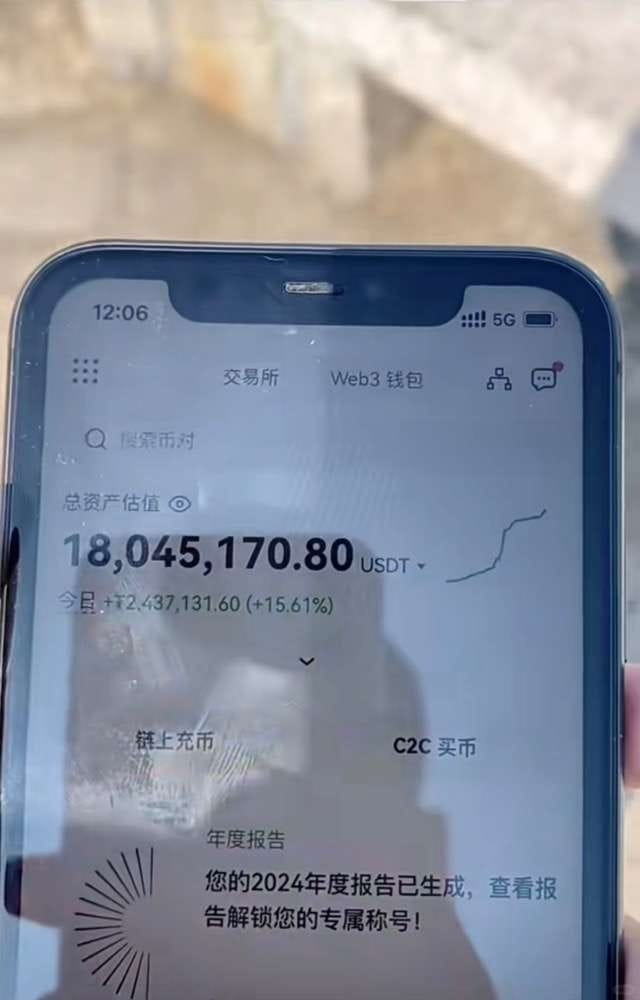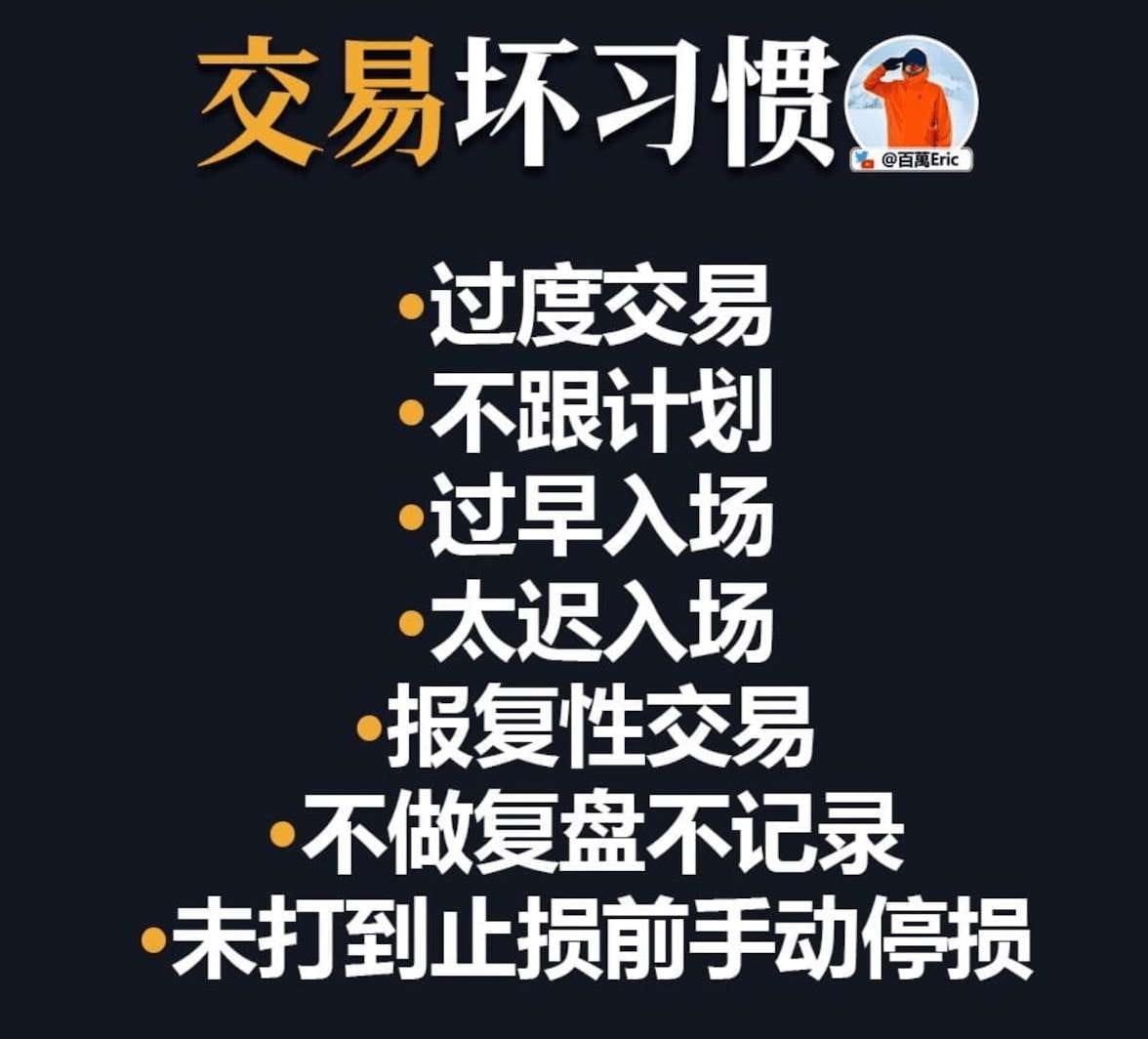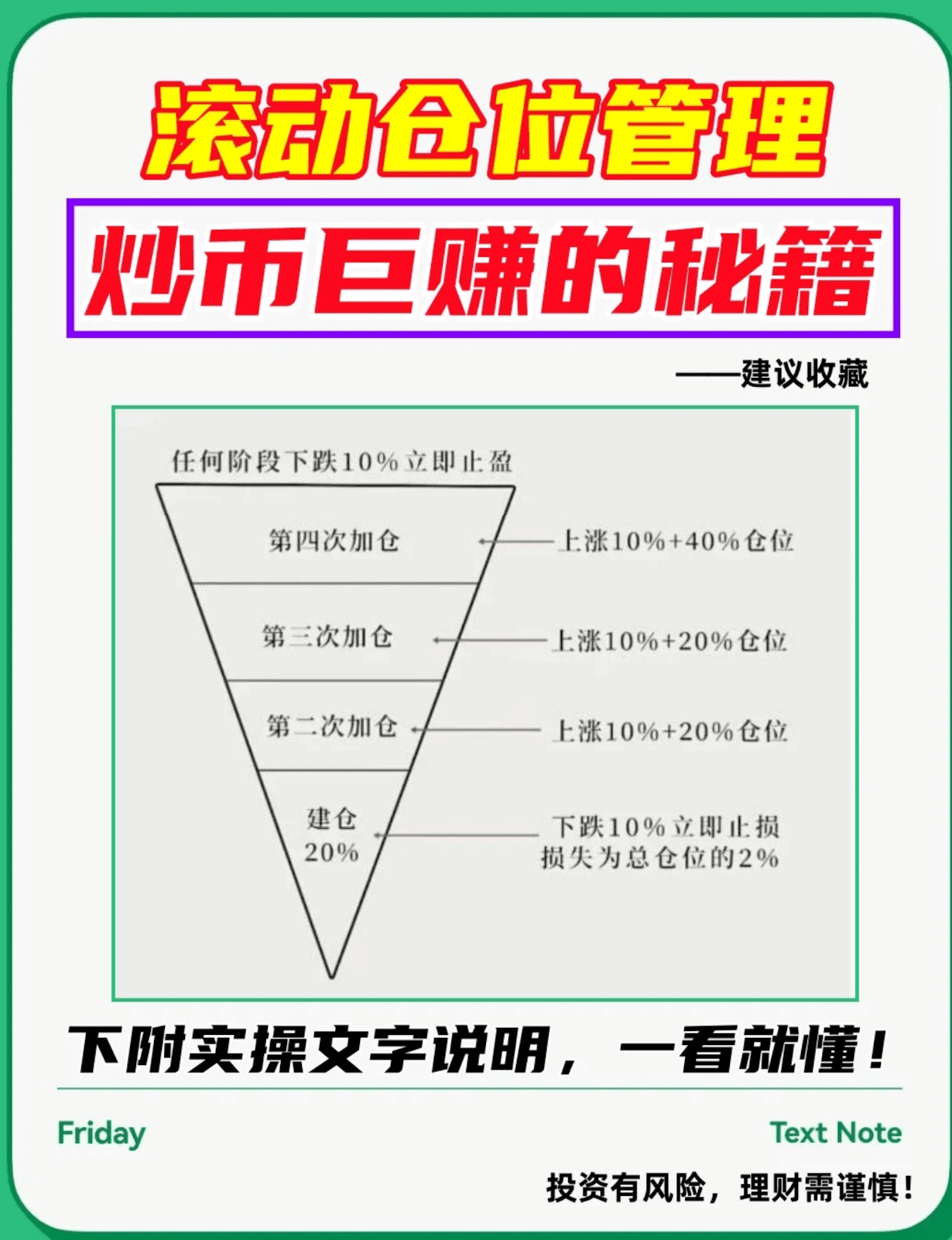I've been trading cryptocurrencies for 10 years, entering the market with 68,000 from my job savings, and now my assets exceed 80 million. I quit my job and became a full-time cryptocurrency trader, supporting my family solely through trading, focusing only on spot trading and occasionally dabbling in contracts. Although I haven't achieved the small goals of turning 10,000 into much more like some people, I am very content and feel secure. I dream that by the end of this year, my account will break 100 million, allowing me to have more capital next year to earn even more money.
If you are determined to make trading cryptocurrencies your primary profession, this article will be your stepping stone, short yet profound!
After 10 years of trading cryptocurrencies, the core trading secret that allows me to achieve stable compound returns

Six iron rules, each packed with useful insights:
First rule: After a surge, if it gradually declines, don't rush to cut losses! If the price suddenly spikes up and then slowly declines like a snail climbing a slope? Don't panic and sell easily. I've seen this too many times; this is often market makers washing out the weak hands, scaring those who can't hold onto their coins, forcing you to hand over your chips at a low price. The real danger is when the price shoots up like a rocket and then suddenly drops off a cliff—this is a trap set by market makers waiting for you to chase high prices! I have lost a good amount of money to this 'guillotine' before.
Second rule: After a sharp drop, if it rebounds slowly, don’t be tempted to catch the bottom! If the price drops like a waterfall, making you anxious, then it rises slowly as if it hasn’t eaten enough? At this moment, keep your hands under control and don’t think, 'It’s dropped so much; it must be time to catch the bottom!' I tell you, 90% of the time, the market makers are still secretly offloading! What you think is a 'bottom' may just be halfway up the mountain. That last bit of false rebound is specifically to trap those who think they are clever 'bottom catchers'. I have suffered this loss before, thinking I was getting a bargain, only to end up deeper in the trap.
Third rule: If the price is high and trading volume is still large, don't be afraid; there may still be potential. If the trading volume suddenly drops off, run quickly! If the price rises to a high level but the volume remains very large, indicating active trading, it suggests that there is still capital playing, and it may push further up. However! If the price is high and the volume drops to almost nothing, making it very low? Trust me, don’t hesitate, sell immediately! Why? Because no one is there to take over! Without new money coming in, the price cannot hold; a crash can happen at any moment. I've seen many coins that halved in days after a high-level volume reduction.
Fourth rule: If a huge volume suddenly appears at the bottom of a decline, don't celebrate too early! Continuous volume increase is the real signal! If the price has been falling for a long time and suddenly one day the trading volume explodes, don't get excited! This could just be a one-time action, a trick by the market makers intentionally attracting your attention, possibly a false rally to offload. The truly reliable bottom signal is when the price has been stagnant at the bottom for a long time, with consistently low trading volume, followed by several days or even weeks of significantly increasing trading volume! This often indicates that large funds are quietly accumulating. The significant market moves I've caught were all after waiting for this continuous volume increase.
Fifth rule: Trading cryptocurrencies involves human nature; trading volume is more important than price! What do you think you are looking at when you stare at the K-line chart every day? Essentially, you are watching a group of people go crazy! Trading volume is the thermometer of market emotions. Price fluctuations? That is merely a result of changes in people's emotions! Increasing volume indicates excitement in emotions (whether greed or fear), and the market is moving; low volume indicates a lack of interest, and the market is stagnant. Prices follow trading volume; don’t get that order reversed! I deeply understand that comprehending volume is a hundred times more important than guessing price fluctuations.
The sixth rule: The word 'no' is the true master! What is the most skillful play? It is the 'no' approach:
Do not be obsessed: if it’s time to be in cash, then be in cash; patiently wait for that truly good opportunity to strike with certainty. Don’t always think that you need to operate at every moment.
Do not be greedy: if it rises, don’t chase it; don’t always think about earning the last penny. I have seen too many people get stuck at the top because of greed, chasing highs.
Do not be afraid: when the price of cryptocurrencies plunges, and the real opportunity arises (for example, when it meets the rules above), dare to act and don’t let fear paralyze you. Of course, this requires real skills and a strong mindset.
This is not about lying flat (being nonchalant) but about cultivating a top trading mindset through countless trials and tribulations. If you can achieve 'not obsessed, not greedy, not fearful', you are not far from being a master. I also stumbled and learned this point over time.
The market has never been short of opportunities; what it lacks are people who can seize those opportunities!

Why do most people end up losing when they enter the cryptocurrency market?
Going all in right away, and getting liquidated at the slightest fluctuation;
After a rise, always feeling it can go higher, holding on tightly and refusing to let go;
When it falls, fearing to sell at the bottom and stubbornly holding on to a deep loss;
Clearly seeing the right direction but not daring to increase position to enhance profits;
Daydreaming of getting rich overnight, only to exhaust the principal in the end—
To put it bluntly, the market hasn't even started moving, but your own mindset has already cut you down!
✅ My iron rules for rolling positions, just these 4:
1️⃣ Small positions to trial and error: always only use 20% of the position to build, if wrong, stop loss, this small loss is completely manageable.
Endure without affecting subsequent operations;
2️⃣ Trend-following position increase: once the direction is confirmed, decisively increase to a 70% position; only by daring to heavily invest can you reap the rewards of large fluctuations.
3️⃣ Profit roll-over: firmly protect your principal, only use the profits earned for speculation; even if you incur losses, it won’t damage the foundation.
4️⃣ Decisive profit-taking: as soon as the peak signal appears, immediately liquidate, never be greedy for the last penny.
Relies on this set of 'emotionless dead rules'; I gradually grow small funds larger.
Let me give two examples from around me;
One fan, with only 900U left in the account, followed this logic and ended up with 4500U in a month.
There is also a sister at home trading along with the rhythm, steadily earning a hundred or so U every day, covering the monthly grocery expenses completely through this operation.
They can succeed not because of extraordinary talent, but for one reason: they do not engage in aimless speculation and honestly execute this logic.
Is there really a 'god' in the cryptocurrency world? To make money, it boils down to three points:
✅ Position management without stubbornness.
✅ Control the rhythm without panic.
✅ Execute without hesitation.
Stop being that fantasizing 'getting rich while lying down' type of retail investor.
Real turning points always start with adhering to discipline and understanding logic!
Turn 'rules' into 'flowcharts'—my 10-year on-chain emotional ATM (a replicable 6-dimensional risk management system + 4 sets of low-threshold strategy templates).
One, a sentence to awaken the dreamers.
An old predecessor entered the market with 50,000 and now has 40 million in on-chain assets. He only sent me one sentence:
The market is always a collective of emotions; set yourself to mute, and it becomes an ATM.
The underlying logic: on-chain assets trade 24/7, and emotions are amplified by leverage 10 times. Whoever can reduce emotional noise holds the probabilistic advantage.
Two, turn the rules into 6 actionable checklists.
1. Entry checklist (calculate risk first, then discuss rewards).
• Write down 'maximum single loss' accounting for ≤ 3% of account net value, then press confirm.
• Initial position ≤ total capital 10%; first verify the logic, then increase the position.
• Use 'simulated warehouse' to backtest 20 times, with a win rate ≥ 55% before transitioning to real trading.
Logic: Position = risk valve; first learn how to breathe, then learn how to sprint.
2. Sideways checklist (box identification + volume filtering).
• Low-level box: Continuous 3 times of volume-reduced retracement at the bottom of the box, OBV (On-Balance Volume) rising → Pre-placed ladder buy orders.
• High-level box: Occurrence of false breakout with increased volume and RSI > 75 → Place ladder sell orders.
• Box width ≥ 8% is worth trading; otherwise, the fees will eat you alive.
Logic: Sideways movements are the 'silent period' for the main force; volume-price divergence is the eve of trend changes.
3. Volatility checklist (quantitative scripts for sudden rises and falls).
• If there is a sudden rise of over 5%: first take a profit of 30%, and use 'trailing stop loss = highest point - 2%'.
• If there is a sudden drop of over 5%: only add to the position once and ensure the interval is ≥ 2 K-lines to avoid 'catching falling knives'.
• If the 15 min trading volume > previous 20 bars average volume 2 times, consider it effective fluctuation; otherwise, treat it as noise.
Logic: Sudden increase in volatility ≈ options gamma squeeze; lock in profits first, then talk about dreams.
4. Buying and selling timing checklist (transform 'yin-yang lines' into probabilities).
• Buy: Bearish candles retracing to 20EMA with reduced volume, MACD green bars shortening.
• Sell: Bullish candles moving away from 20EMA with increased volume, MACD red bars diverging.
• No trade during non-sideways movements: if the fluctuation range is < 3%, the win rate is naturally < 45%, directly observe.
Logic: Moving averages represent the market's 'average cost'; a volume-reduced retracement indicates short-seller exhaustion, while a volume increase away indicates long-seller exhaustion.
5. Risk checklist (mandatory calm mechanism).
• If the daily floating loss exceeds 3%, immediately shut down and take a 30-minute walk to prevent 'revenge trading'.
• After 3 consecutive stop losses, automatically downgrade to 'simulated account' backtesting for the day, and return to real trading the next day.
• On the first trading day of each month, forcibly withdraw 20% of profits; secure those profits.
Logic: Incorporate 'emotional control' into system variables, using processes to hedge against human nature.
6. Mental checklist (turn backtesting into a 20-character Weibo post).
• Template: Entry reason + exit emotion + next improvement.
• Clear 'emotional position' at fixed times each week, leaving only logical positions.
• Read once every quarter (trading psychology analysis), treat mindset upgrades like technical upgrades.
Logic: Backtesting = secondary learning; emotional position = a breeding ground for black swans.
Three, 4 sets of low-threshold strategy templates (with parameters and backtesting ideas).
① Volatility grid
• Indicators: BOLL middle track ±2σ.
• Grid spacing: ATR(14) × 0.618.
• Backtest: 2022.01-2023.12, ETH 4h cycle, annualized return 24%, maximum drawdown 8%.
② Follow the breakout.
• Condition: Daily K-line closes above the upper boundary of the box, and the next day it retraces without breaking the upper boundary by 50%.
• Stop loss: lower boundary of the box -1%.
• Backtest: 2021.01-2023.12, BTC daily line, win rate 52%, profit-loss ratio 2.8.
③ Support/Resistance reversal.
• Condition: Previous high/low + volume mutation + RSI divergence.
• Profit-loss ratio 1:1, R:R ≥ 1.5 before opening a position.
• Backtest: 2023.01-2023.12, SOL 1h, win rate 56%, annualized return 31%.
④ Time period filtering.
• Morning & afternoon: place pre-set orders, ATR stop loss, low volatility, high win rate.
• Evening & early morning: reduce position to 5%, ATR × 0.5 stop loss, quick in and out.
• Backtest: 2023.01-2023.12, BNB 15 min, evening trading group's reward/risk ratio 3.2, morning trading group 1.8.
Fourth, solidify the process into habits.
1. Print 6 checklists and stick them on the side of your screen.
2. Write 4 sets of templates into a mobile memo and read them aloud before the market opens.
3. Develop a muscle memory for the '20-character review' and complete it in the last 5 minutes before sleep.
The market does not reward the smartest people; it only rewards those who can execute simple actions to the extreme.
When you set your emotions to mute, what remains are friends of probability and time.

To survive long-term in the cryptocurrency market, in addition to the ability to analyze various technical indicators and access first-hand news sources, one must also have the ability to manage one’s own positions. The following rolling position method is a relatively stable compound return strategy I summarized over 10 years in the market (I recommend everyone to like and save this to avoid losing it later). Here comes the hard facts:
Only trade mainstream varieties, avoid altcoins, and remember not to chase highs when building positions; accumulate positions gradually on dips.
1. Divide your capital into 5 parts; take out 1 part, which is 20%, to build a solid base.
2. Once the base position is established, if a 10% decline occurs, immediately stop loss (only lose 2% of the total position). If it rises by 10%, then add 20% to the position.
3. At this point: 40% position, wait; if it rises another 10%, then increase position by 20%.
4. At this point: 60% position, pay attention to observation; if it rises another 10%, then increase the position by 20%.
5. At this point: 80% position; if it rises another 10%, then increase position by 40%.
At this point: I have already gone all in, so please be patient and wait for the rise. After another 10% rise, sell 20%, selling while it rises to lock in profits. If it drops 20%, clear the position completely—secure the profits!
7. A 40% base position can remain unchanged for a long time; the maximum position is 60-80%, and always keep 40% of the capital to cope with unexpected situations for reverse position increases.
This method sounds complex, but for those with insight, it is very simple—just keep good trading records; having records prevents mistakes, buy low and sell high. How much to buy when it falls and how much to sell when it rises depends on the liquidity of the cryptocurrency. Trading requires insight, learning actively and applying it. Doing this long-term will make it second nature, and soon, earning money will be as easy as breathing. I’m not exaggerating.

In the cryptocurrency market, many retail investors easily fall into the trap of frequent trading and blindly following trends. However, the true way to succeed in cryptocurrency trading does not depend on the number of trades; it relies on rationality and patience.
First, clarify your risk tolerance. Knowing how much loss you can bear is essential to formulating reasonable position management.
Remember not to recklessly go all in; if your mindset is lost, no matter how much money you have, it will be like a basket fetching water.
Avoid being fixated on gains and losses in cryptocurrency trading.
Trading is disciplined, without emotions, no 'ifs', no fear, no greed; all operations are based solely on whether it is appropriate and whether it has been executed.
Emotional people do not make good traders. Calm and composed.


